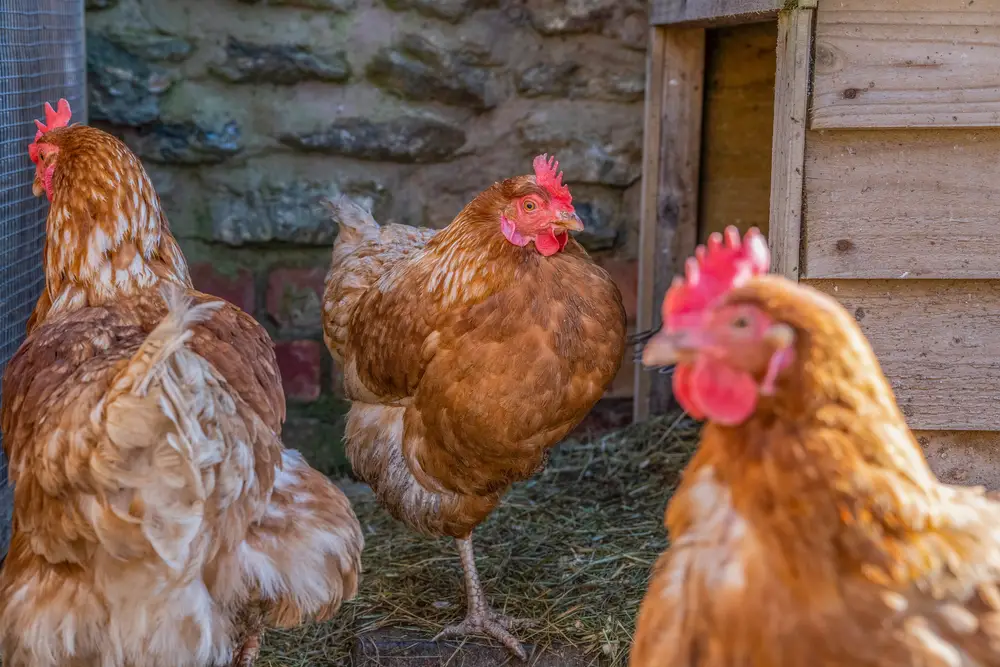Red Ranger chickens are a dual-purpose breed of chicken that are primarily used as meat birds, but they do lay up to 170 eggs per year. They are becoming increasingly popular overseas, with organic farmers and homesteaders loving this breed as they can be ethically raised.
Little information is known about what breeds were crossed to produce the Red Ranger, but it is theorized that Delawares, Cornish Cross chickens, and Rhode Island Red genetics were involved.
Red Rangers are often confused with similar hybrid breeds such as Dixie Rangers, and the Freedom Ranger chickens, which are also dual-purpose birds with reddish brown feathers that come from different hatcheries.
Broiler breeds like Red Ranger chickens were made to fill a hole in the market.
It takes between 5 and 6 months for the average heritage chicken to be ready for butchering and there was high demand for birds that could be culled earlier, but still taste better than Cornish rocks. Red Rangers are ready for butchering at just 12 weeks and are known for their flavorful meat.
Red Rangers became a popular alternative to white broilers as they are dual-purpose chickens, with little-known health problems, and can live a more natural lifestyle than their commercialized cousins.
Table of Contents
Red Ranger Chicken Breed Overview
| Recognized Breed Name | Hybrid Chicken that not recognized by the APA |
| Lifespan | 1 to 2 years |
| Coloring and Pattern | Light brown with reddish tones Bare yellow legs |
| Weight | 6 to 10lbs |
| Comb Type | Single |
| Distinctive Details | Rectangular-shaped body, large thighs with smaller breasts |
| Feather Type | Smooth |
| Heritage Breed | No |
| Tolerant to Heat? | Yes |
| Tolerant to Cold? | No |
| Meat Production Breed? | No |
| Egg Production Breed? | Yes |
| Lays in Winter? | No |
| Egg Size | Medium |
| Egg Color | Light brown |
| Egg Production | 150 to 170 |
| Starts Laying | 16 to 18 weeks |

Temperament
Red Rangers are one of the best meat birds in terms of meat quality and flavor, but they also are independent and active. Unlike other broilers, Red Rangers love to be outside and act more like a heritage breed.
They are known to have survival instincts and will protect themselves from predators if attacked, but generally speaking, aren’t aggressive birds and do get along well with other breeds in mixed flocks.
Red Ranger Chicken Coop
The most popular chicken coop for meat chickens is the chicken tractor so they can safely free range. If you prefer to set up a standard chicken coop and have a separate chicken run, that also works well for these red broilers.
Red Rangers don’t have the same space requirements as some heritage breeds, but should still have 5 to 10 square feet of space per chicken inside the chicken coop.
Perches should be placed inside the chicken coop at the same height, and be off the ground to help prevent parasites from getting to your flock. You will also want to ensure the chicken coop is sufficiently climatized, and ventilated so your birds stay healthy.
If you plan to breed baby chicks, a separate hatchery will need to be set up inside or next to the coop, with an incubator and brooders for baby chicks after they hatch.
It should be noted that hybrids like Red Rangers do not breed true. If you want more Red Ranger chicks you will need to cross two pure breeds if you wish to breed them yourself.
Red Ranger Chicken Feeding and Health
Most broiler breeds are known for poor health and rarely live for more than a few months due to rapid growth. Red Rangers are an exception and have no known health issues.
Red Rangers can live for a few years rather than a few months and don’t suffer from the same heart issues that other fast-growing meat birds do.
This good health may be due to the fact that Red Rangers are excellent foragers. The more they are allowed to forage, the better their meat and eggs will taste.
The feed requirements of red broilers are somewhat different than egg-laying heritage chickens, specifically in the amount of protein that is required.
Standard chick starter and grower feed should be used for young Red Rangers, but once they reach 16 weeks, they should be switched to a higher protein pellet feed containing around 20 percent protein.
This extra protein allows for the growth rate required of broiler chickens, though it should be noted that Red Rangers do not have plentiful breast meat and are more known for dark meat.
In addition to their feed, always provide chick grit so your flock can properly digest their food.
Meat chickens will also taste better if they have a variety of healthy snacks fed to them on occasion, especially mealworms and fresh veggies. Just be sure extra snacks are safe for chickens, and properly prepared.
FAQs
Do Red Ranger Chickens Lay Eggs?
Yes! Red Ranger hens lay between 150 and 170 eggs per year. They are more often used as meat birds, but they are decent egg producers as well.
How Much do Red Ranger Chickens Weigh?
Red Ranger hens weigh between 6 and 7lbs when they reach maturity. Red Ranger Roosters clock in at 7 to 10lbs.
What is the Average Lifespan of a Red Ranger Chicken?
Red Ranger chickens have a longer lifespan than most broiler breeds and live for around 2 years on average.
What are the Favorite Foods of Red Ranger Chickens?
Red Ranger chickens love mealworms and appreciate fresh fruits and veggies such as cucumber and watermelon in addition to their normal, high-protein pellet feed.

